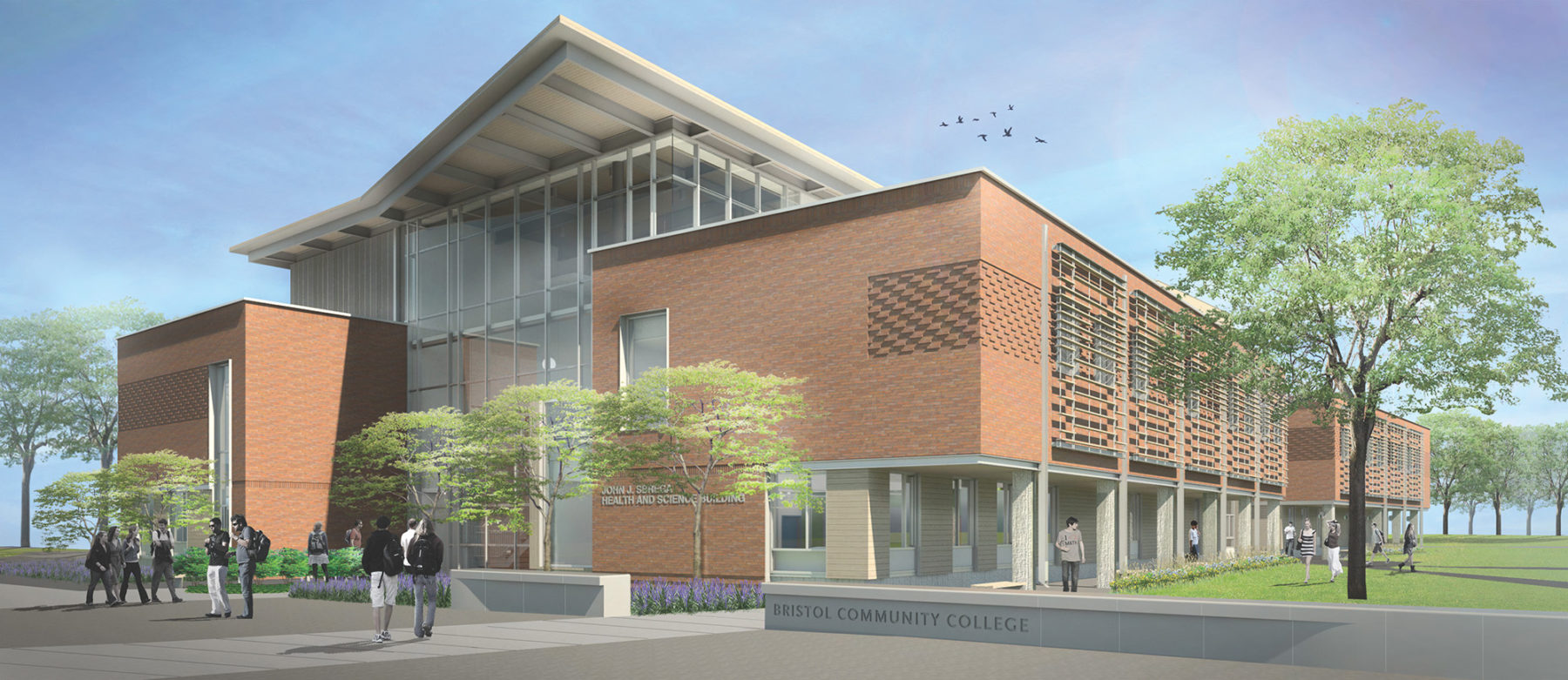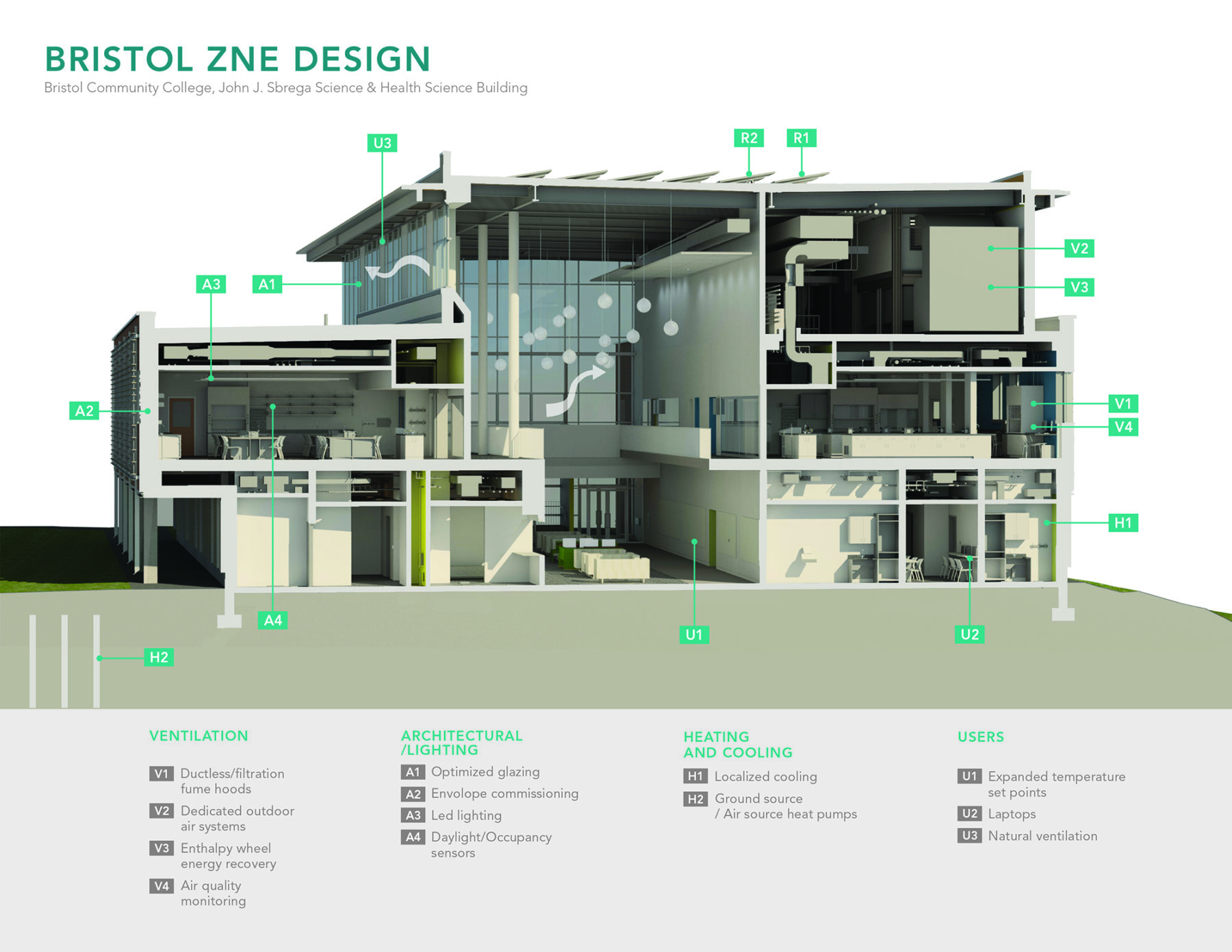Q&A with Tamar Warburg—Sasaki’s Sustainability Director
Learn what drives Sasaki's Sustainability Director in the work she does
 Sasaki
Sasaki

Sasaki Senior Associate Jim Moses, AIA, LEED AP, and Jacob Knowles from BR+A recently presented on Bristol Community College’s John J. Sbrega Health and Science Building, the campus’ first Zero Net Energy (ZNE) building, at the Tradeline College and University Science Facilities 2015 conference. Read on for a Q&A with Jim:
Q: As the project designer from Sasaki Associates for Bristol’s ZNE building, can you give a brief overview of what ZNE means and what the building strategies are?
A: In the strictest sense, ZNE is defined as an annual balance of energy consumed and energy produced by a building, such that one negates the other. This can be difficult to achieve in the context of a science building, where energy use intensity (EUI) tends to be very high, mainly because of ventilation, heating, and cooling requirements. The overarching approach is to drive the demand side of the equation as low as possible and practical, eliminate fossil fuel-based heating and cooling, and employ building and/or site-generated renewables to power the building. The combination of strategies may look different depending on the building type. At BCC, about seventy percent of our energy savings came from reducing ventilation demand (using filtration fume hoods, reducing minimum air changes by monitoring air quality, and enthalpy wheel heat recovery); about fifteen percent from using efficient heating and cooling technologies (localized cooling and a hybrid source heat pump); and about ten percent from passive architectural strategies like shading, high efficiency glazing, high performance envelope, and LED lighting. User behavior is critical as well and accounts for about five percent of the expected reductions: natural ventilation, expanding the allowable indoor temperature range, and using laptops are all important pieces of the puzzle. Relative to our baseline building (290 kBtu/sf-yr), we reduced EUI by about 80% to 55 kBtu/sf-yr.

Q: What opportunities and challenges do these buildings represent both during construction and throughout their life cycles? As we see with Life Cycle Cost Analyses (LCCAs), utilities and facility maintenance play a huge part in the overall cost of a building—how do those costs differ for a ZNE building in comparison to a traditional building?
A: Construction challenges, which exist regardless of whether a building is ZNE or not, will depend on the technologies employed and whether they’re familiar to local trades. The best bet is to pre-qualify the right subcontractors, something that unfortunately is not always possible in a public bid environment.The operational savings are where the rubber hits the road. The savings at Bristol is real money that can be used for meaningful things instead of being burned. There may be some unique maintenance challenges related to new technologies, or technologies that might be new to a particular client. In general, though, the goal is to use familiar technologies in a smarter way. As long as buildings are designed, built, and used by human beings on Planet Earth, they will need to be maintained. The better they are maintained, the longer they will last and have uses beyond what they were originally designed for.
The issue of capital cost is interesting too; at Bristol we had to show the client that we could accomplish ZNE within a fixed budget. With a carefully considered and holistic approach, we were able to balance costs and savings. At the end of Schematic Design, the ZNE building cost about $200,000 less than a “high performance” building, not including operational savings. As renewables are becoming more competitive with fossil fuels, it’s hard to imagine we won’t see more of these projects in the near future. Many of our clients have climate action plans that aim for carbon neutrality by 2030 or 2050. For many, it will be difficult to achieve those goals without including ZNE buildings in their portfolios.
Q: How many ZNE buildings have been built?
A: Unfortunately, there’s not a reliable database of ZNE buildings worldwide. In the US today it looks like there are about 40 (according to the New Buildings Institute). More than half of those are on the West Coast, where the climate is very moderate. When we began developing the Sbrega Building’s ZNE approach, we had a hard time finding good precedents for what we were trying to accomplish. Not only were there few models in our climatic zone, but also there were few with the same baseline energy intensity. Finding both in the same project was impossible, so in a sense we were reinventing the wheel.
Q: As interest and awareness spreads, has the number of ZNE buildings begun to shoot up, or is growth still pretty linear?
I don’t know that I can answer the question of growth. But interest seems to be increasing. Our Tradeline session, for example, was very well attended and the attendees were extremely engaged. This certainly has something to do with the makeup of the audience, who spend at least part of their time worrying about the heavy energy expenditures of science buildings. It’s also been true generally in the last year and a half when we’ve presented the project: lots of interested people asking informed questions.
Q: A community college seems an unlikely candidate to invest in such a facility. Can you give some insight into Bristol’s decision to pursue this project?
A: It probably begins with Jack Sbrega, the president of the college, who was a founding signatory to the American College and University Presidents’ Climate Commitment (ACUPCC). That represents a statement of seriousness with regard to climate change, because there are ongoing reporting requirements that are in the public domain. Anyone can see what kind of progress your institution is making toward its goals. BCC’s climate action plan sets a goal of carbon neutrality by 2050—especially ambitious for a commuter campus, half of whose emissions come from vehicles. Over the last ten years or so they’ve implemented a number of renewable energy projects, including putting PV arrays on almost every roof. They were awarded a grant to fund the installation of a wind turbine, which unfortunately and unsurprisingly was stopped by neighbors. Fortunately for our project, those funds were redirected to the Sbrega Building for a rooftop PV array and to defray the cost of the heat pump system. Probably the most significant thing the campus has done so far is to enter into a power purchase agreement with a provider, who built a 3.2 MW PV array on one of the parking lots. This allowed the array to be built at no cost to the college and gave them a fixed rate for electricity for twenty years. It also provides them with a shaded parking lot and one they won’t have to plow in the winter.
Q: So, a ZNE building is obviously the “whole package”: a single building entirely off the grid. What advice do you offer to clients who are not interested or unable to pursue a ZNE building, but are interested in implementing some ZNE building systems? If they can only choose a few high-performance, off-the-grid systems, where should they start?
A: I think it’s important to clarify that a ZNE building is not necessarily “off the grid.” In the case of Bristol, the energy they generate on site goes back into the grid. It’s unlikely that the grid is going to become obsolete. The means of generation is beginning to shift from fossil fuels to renewable sources, and that generation will become more distributed, but the grid will most likely remain because so much has been invested in building it.
ZNE is not so much about picking items from a menu as it is about re-calibrating a mindset to a more holistic approach of looking for the most appropriate combination of strategies for a given project, which reduce energy use and eliminate reliance on fossil fuels. But to try to answer the question directly, if the goal is to wean ourselves off of fossil fuels, the burning of which contributes to a warming planet, it seems like a good place to start would be in generating renewable energy. Our clients tend to own numerous buildings and open land, both of which present opportunities in their surface area. This was Bristol’s approach: installing photovoltaics on the roofs of their buildings, as well as building a site based array. At the same time, each new construction and major renovation project should look for the mix of strategies appropriate to the project.
Q: What are some other big questions you encounter when talking about ZNE? Have you come across much criticism or disbelief?
A: The scepticism we’ve encountered has more to do with concerns about the claim that the Sbrega Building is ZNE when we are not generating enough power on the building to balance consumption. We needed twice the roof area available to us to fit enough PV on the building. We’re able to say the building is ZNE because Bristol will buy back on the open market the Renewable Energy Certificates (RECs) produced by their campus array. This is more a question of accounting than anything. If the Sbrega Building is operated according to the energy model, it will use less than 20% of the campus PV array. For campuses, a combination of building and site based renewables, together with demanding much greater efficiency in new and renovated buildings, is the way to achieve a ZNE portfolio. As owners of often millions of square feet of buildings, colleges and universities are in a unique position to lead the way, showing that it makes environmental and economic sense to push for ZNE.
Q: What benefits does a ZNE design offer the client and the environment? Are there other beneficiaries?
The major benefits to the client have to do with operational cost savings, which frees up funds for other uses. At Bristol, between the Sbrega Building and the site PV array, we’re anticipating annual savings of $230,000, which is equivalent to annual tuition for about fifty students. The environmental benefits have to do with shrinking the market for carbon based technologies, while growing the market for renewables; as Bill McKibben (founder of 350.org) said in praise of President Obama’s recent decision to kill the Keystone XL pipeline project, “keep carbon in the ground.” If carbon stays in the ground it’s not being burned and emitting greenhouse gases. We’re particularly excited about the Sbrega Building because it will show that it’s possible to achieve ZNE for a science building, an energy-intensive building type, in a relatively cold climate.
It’s our hope that, beyond the building operating at ZNE, it becomes a model for other building owners and designers. That would begin to magnify the impact of the project. Tradeline is only the latest of numerous talks we’ve been giving about the Sbrega Building. We’re working hard to get the story out there and inspire people to seriously consider this approach as they plan their projects.
Truly, we’re all beneficiaries. Over the summer the Department of Defense published a report describing the national security implications of climate change. There is a fairly convincing argument being made now that the war in Syria and ongoing mass migration we are seeing from Syria to Europe began with drought caused by climate change, and exacerbated by political indifference, or worse. The Pentagon says that this will become more the norm as the effects of climate change accumulate. Keep carbon in the ground.
Jim Moses is an architect who works primarily with higher education clients. He has a special interest and background in projects for STEM environments and planning. From programming to construction administration, his thoughtful and pragmatic approach to this building type makes him invaluable to planning and design teams in Sasaki’s Campus Studio. LEED accredited and registered in Massachusetts, Jim is affiliated with the AIA, BSA, and DoCoMoMo. He is also on the design faculty of the Boston Architectural College.